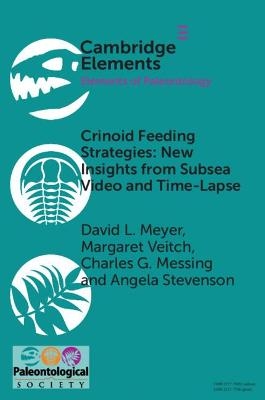
Crinoid Feeding Strategies: New Insights From Subsea Video And Time-Lapse
Seiten
2021
Cambridge University Press (Verlag)
978-1-108-81007-4 (ISBN)
Cambridge University Press (Verlag)
978-1-108-81007-4 (ISBN)
This Element includes time-lapse video made in 1983 on film, followed by recent digital videography from submersibles and remotely operated vehicles of deep-sea crinoids, revealing behaviors in taxa never before seen in life.
Modern videography provides an ever-widening window into subsea echinoderm life with vast potential for new knowledge. Supported by video evidence throughout, this Element begins with time-lapse video made in 1983 on film, using an off-the-shelf camera, flash, and underwater housings. Although quality has now been significantly improved by digital imagery, films from over thirty years ago captured crinoid feeding behavior previously unknown and demonstrated a great potential to learn about many other aspects of their biology. This sequence is followed by several examples of recent digital videography from submersibles of deep-sea crinoids and remotely operated vehicles (ROVs) (stalked and unstalked), as well as close-up video of crinoids in aquaria. These recent studies enabled a new classification of crinoid arm postures, provided detailed views of food particle capture, and revealed a wide range of behaviors in taxa never before seen in life.
Modern videography provides an ever-widening window into subsea echinoderm life with vast potential for new knowledge. Supported by video evidence throughout, this Element begins with time-lapse video made in 1983 on film, using an off-the-shelf camera, flash, and underwater housings. Although quality has now been significantly improved by digital imagery, films from over thirty years ago captured crinoid feeding behavior previously unknown and demonstrated a great potential to learn about many other aspects of their biology. This sequence is followed by several examples of recent digital videography from submersibles of deep-sea crinoids and remotely operated vehicles (ROVs) (stalked and unstalked), as well as close-up video of crinoids in aquaria. These recent studies enabled a new classification of crinoid arm postures, provided detailed views of food particle capture, and revealed a wide range of behaviors in taxa never before seen in life.
1. Feather Stars at Lizard Island, Great Barrier Reef (14O 38' S, 145O 30'E); 2. Arm Postures in Living Crinoids; 3. Mechanism for Particle Interception and Transport in Comatulid Crinoid Florometra Serratissima: Presenting a Range of Particle Sizes from Mesocosm Observations; 4. Feeding Postures in a Pentacrinoid Florometra and Responses of Democrinus (Bourgeticrinidae) and Cenocrinus (Isocrinidae) to Increased Current.
| Erscheinungsdatum | 21.06.2021 |
|---|---|
| Reihe/Serie | Elements of Paleontology |
| Zusatzinfo | Worked examples or Exercises |
| Verlagsort | Cambridge |
| Sprache | englisch |
| Maße | 151 x 229 mm |
| Gewicht | 51 g |
| Themenwelt | Naturwissenschaften ► Biologie ► Evolution |
| Naturwissenschaften ► Geowissenschaften ► Mineralogie / Paläontologie | |
| ISBN-10 | 1-108-81007-1 / 1108810071 |
| ISBN-13 | 978-1-108-81007-4 / 9781108810074 |
| Zustand | Neuware |
| Haben Sie eine Frage zum Produkt? |
Mehr entdecken
aus dem Bereich
aus dem Bereich
Wie die Vernichtung der Arten unser Überleben bedroht - Der …
Buch | Softcover (2023)
Penguin (Verlag)
15,00 €


